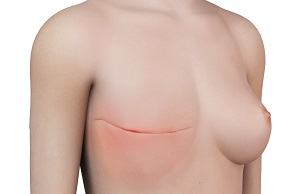
What is Flap Reconstruction?
Flap reconstruction is a surgical procedure that involves transferring healthy skin tissue from one location on your body to another.
Flap surgery can be utilized for procedures such as breast reconstruction, trunk, and extremity reconstruction, or for reconstruction of facial features or nerves.
Breast reconstruction with flap surgery is a complex procedure performed by a plastic surgeon to restore shape to your breast after a mastectomy (surgical removal of one or both breasts) by taking a section of tissue from one area of your body and relocating it to create a new breast mound.
What are the Types of Flap Reconstruction?
There are different types of flap reconstruction procedures that are classified based on the source of the skin flap obtained from your body to perform the flap surgery. These include:
- DIEP Flap Reconstruction: The DIEP (deep inferior epigastric perforator) flap is a newer procedure that uses fat, skin, blood vessels, and minimal abdominal muscle tissue to form a new breast mound with reattachment of blood vessels through microsurgery. This is a less painful and fast recovery procedure compared to TRAM flap and helps in preserving abdominal muscles to maintain strength and function in your abdomen.
- TRAM Flap Reconstruction: The TRAM (transverse rectus abdominis muscle) flap is a procedure that uses skin, muscles, and fat from your lower abdomen to form a new breast mound. The skin, blood vessels, fat, and at least one abdominal muscle are transferred from the abdomen to the chest.
- SIEA Flap Reconstruction: The SIEA (superficial inferior epigastric artery) flap procedure is a less invasive option that uses abdominal tissue as in DIEP and TRAM flaps, but relies on blood vessels that are located not as deep within the abdomen.
- Latissimus Dorsi Flap Reconstruction: In this type of reconstruction, your surgeon tunnels muscle, fat, skin, and blood vessels from your upper back, under the skin to the front of the chest. This approach is used for small and medium-sized breasts or for creating a pocket for a breast implant. This provides added coverage over an implant and makes a more natural-looking breast than just an implant alone.
- GAP Flap Reconstruction: The gluteal free flap or GAP flap is a reconstruction surgery that uses tissue from your buttocks to create a breast mound. The blood vessels, skin, and fat are cut out of the buttocks and then transferred to the chest. The GAP flap is an option for women who prefer not to use their abdominal site due to history of previous abdominal surgery, thinness, or aesthetic reasons.
- TUG Flap Reconstruction: The TUG (transverse upper gracilis) flap is a procedure where your surgeon uses muscle and fatty tissue from the bottom fold of the buttocks extending to the inner thigh to create a new breast mound. The muscle, skin, and blood vessels are then cut and transferred to the chest, and the tiny blood vessels are joined to their new blood supply.
Procedure for Flap Reconstruction
Flap reconstruction is a major procedure that is undertaken under general anaesthesia. Your surgeon will locate the tissue donor site and make an incision across the selected site for tissue extraction. Based on the site location, a flap of skin, muscle, fat, and blood vessels will be loosened and removed. Your surgeon will transfer the removed flap to your chest area to construct a new breast mound. Your surgeon will then undertake the complex task of connecting the flap’s blood supply to the tiny blood vessels under the arm or behind the breastbone. Your surgeon then shapes the extracted tissue to create a new breast mound and connects it to the blood supply. Your surgeon will close the incisions in your new breast and the tissue donor site with stitches.
Postoperative Care and Instructions
Flap reconstruction is a complex surgery that takes 8 to 12 hours to complete. Post-op care and instructions include:
- You will be shifted to the recovery room post surgery where you will spend a few days.
- You may have drainage tubes in place to remove excess fluid that may collect in the surgical site.
- You will experience some pain and discomfort and your doctor will prescribe pain medicines for pain control.
- You will have some soreness, swelling, and bruising for 2 to 3 weeks, and your doctor will provide adequate medications for faster healing and overall recovery.
- Your doctor will provide you with instructions on bathing, showering, and wound care.
- You will be able to resume normal activities within a couple of months but may have activity restrictions on strenuous physical activities.
- A series of follow-up appointments will be scheduled to monitor your progress.
Risks and Complications Associated with Flap Reconstruction
As with any surgery, flap surgery for breast reconstruction may involve potential risks and complications, such as:
- Poor wound healing
- Changes in breast sensation
- Bleeding
- Infection
- Abdominal wall hernia or weakness
- Fluid or blood accumulation
- Scar formation
- Tissue rejection
- Breast lumps
- Necrosis (tissue death)
- Loss of sensation at the tissue extraction site
Benefits of Flap Reconstruction
Flap surgery for breast reconstruction offers many benefits, including:
- Helps to have natural looking breasts
- Avoids the need for using external prostheses inside your bra
- Improves your body image and self-esteem
